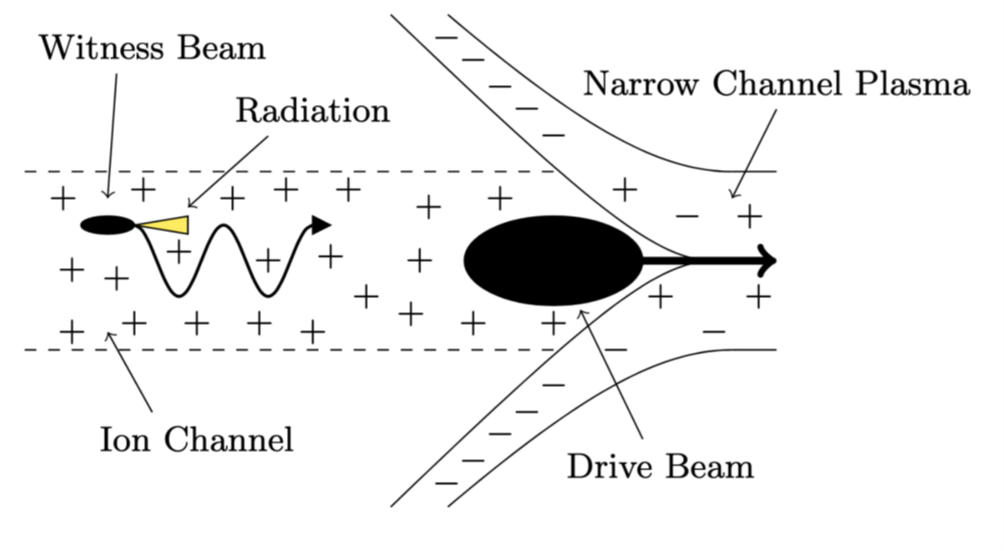Sparc-Lab BETAtron radiation TEST-bed
Local Manager: Alessandro Cianchi; PI: Enrica Chiadroni (LNF).

This research focuses on betatron radiation emission in beam-driven plasma wakefield acceleration at SPARC_LAB [1], as a test-bed for plasma-based undulator development. Within the EuPRAXIA ESFRI facility [2] and EuPRAXIA@SPARC_LAB project [3], there is strong interest in compact plasma-based user facilities, not only for acceleration but also for FEL radiation delivery. Efforts have been made to miniaturize diagnostics, detection devices, and transfer lines, e.g., using active plasma lenses [4]. However, conventional undulators remain bulky and costly. Advanced undulator concepts are key to overcoming these limits, with betatron motion in ion channels offering a compact alternative. Plasma-based electron manipulation concepts date back to the 1980s–90s [5], but recent studies on underdense plasma undulators have renewed interest. Plasma wave undulators [6] have been explored with laser plasma acceleration [7,8], showing tunability in wavelength and polarization [9,10]. Experimental validation is now needed to demonstrate their feasibility as compact FEL sources [11]. This experiment optimizes, via simulations, betatron radiation from a single driver-like bunch and a two-bunch comb-like structure at SPARC_LAB (~120 MeV), using 10 cm plasma capillaries. A crucial aspect is the plasma source for ion-column production, ensuring a “wakeless” regime to minimize witness beam acceleration. Betatron radiation, carrying information on beam-plasma interaction, will serve as a single-shot, non-intercepting beam diagnostic [12]. This study aligns with the PNRR-EuAPS project at INFN-LNF, which aims to establish a laser-driven betatron-based X-ray facility at SPARC_LAB for XPCI, XAS, and XES applications.
[1] M. Ferrario et al. SPARC_LAB present and future. Nucl. Instrum. Methods B 309, 183–188, (2013).
[2] Assmann, R. W. et al. Eupraxia conceptual design report. Eur. Phys. J. Spec. Top. 229,3675–4284 (2020).
[3] M. Ferrario et al., “EuPRAXIA@SPARC_LAB Design study towards a compact FEL facility at LNF” Nuclear Inst. and Methods in Physics Research, A 909 (2018) 134–138.
[4] Active Plasma Lenses
[5] D.H. Whittum, A.M. Sessler, J.M. Dawson, Ion-channel laser, Phys. Rev. Lett. 64 (1990) 2511–2514, http://link.aps.org/doi/10.1103/PhysRevLett.64.2511.
[6] R. Williams, C. Clayton, C. Joshi, T. Katsouleas, Studies of classical radiation emission from plasma wave undulators, IEEE Trans. Plasma Sci. 21 (1) (1993) 156–166, http://dx.doi.org/10.1109/27.221115.
[7] S. Corde, K. Ta Phuoc, Plasma wave undulator for laser-accelerated electrons, Phys. Plasmas (1994-Present) 18 (3) (2011) 033111, http: //dx.doi.org/10.1063/1.3569827, URL http://scitation.aip.org/content/aip/journal/pop/18/3/10.1063/1.3569827.
[8] S. Rykovanov, C. Schroeder, E. Esarey, C.R. Geddes, W. Leemans, Plasma undulator based on laser excitation of wakefields in a plasma channel, Phys. Rev. Lett. 114 (2015) 145003, http://dx.doi.org/10.1103/PhysRevLett.114.145003.
[9] J. Luo, M. Chen, M. Zeng, J. Vieira, L. Yu, S. Weng, L. Silva, D. Jaroszynski, Z. Sheng, J. Zhang, A compact tunable polarized X-ray source based on laser-plasma helical undulators, Sci. Rep. 6 (2016) 29101, http://dx.doi.org/10.1038/srep29101.
[10] I. Andriyash, R. Lehe, A. Lifschitz, C. Thaury, J.-M. Rax, K. Krushelnick, V. Malka, An ultracompact X-ray source based on a laser-plasma undulator, Nature Commun. 5 (2014) http://dx.doi.org/10.1038/ncomms5736.
[11] B. Ersfeld et al., New J. Phys. 16, 093025 (2014).
[12] A. Curcio et al., Phys. Rev. Accel. Beams 20, 012801 (2017).



















































































































